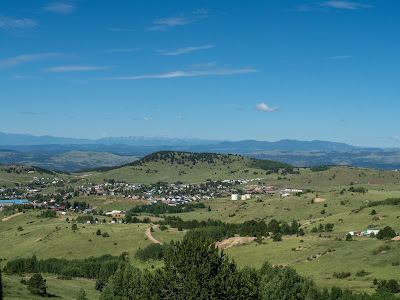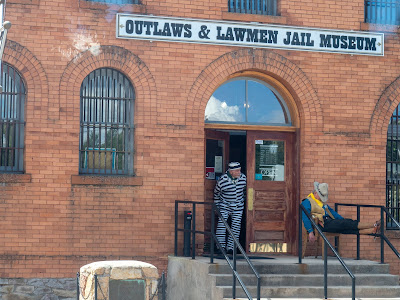The highlight of our short visit to Colorado Springs was a visit with my good friend, Carolyn Stinson Cochran. Carolyn and I have known each other since first grade, and have many fond memories of our growing-up years in Hamilton, Texas. We have kept in touch over the years, and enjoy the times we have to get together.
Carolyn is an outstanding tour guide, and always has something new and fun to show us when we are in town. This trip, Carolyn took me to visit the historic gold mining towns of Cripple Creek and Victor about an hour west of Colorado Springs.
On the way into town, we stopped at the museum and visitor center that overlooks the town and the adjacent mines. Carolyn wanted me to watch a short film that gives an overview of the history of the area. We were so disappointed to learn that the film would not be shown to the public until later in the afternoon. However, fate or God intervened and we saw a brochure advertising a narrated trolley tour of the area.
We thought that sounded like a good option, so we drove into town, and were able to get the last two tickets! Here Carolyn visits with one of the tour guides.
We thought that sounded like a good option, so we drove into town, and were able to get the last two tickets! Here Carolyn visits with one of the tour guides.
Talk about a wonderful experience! The tour guides are members of the local historical society and are in period costume of the late 1800s. They are full of more facts about the area than I could absorb. A couple I remember…Gold was discovered in 1890 by Bob Womack. By 1900, 500 mines had been discovered, among them the Independence Mine. At the height of the mining boom, the Cripple Creek area boasted thirteen millionaires, and that was when gold was worth $20 per ounce instead of $1430 as it is today. Another interesting fact is that the value of gold taken out of the Cripple Creek area mines is greater than the total of gold mined during the California and Alaska gold rushes combined.
Here is a piece of gold ore that they passed around for us to look at and hold…and give back!
The tour lasted almost 2 hours and traveled through Cripple Creek and Victor. There were stops at many historic buildings, and “characters” from history got on the tour bus and gave us their version of history.
At the old jail, a “prisoner” escaped and tried to convince us that he was, in fact, innocent.
At the old cemetery, we had a visit from one of the custodians who told us about some of the famous people buried there. He pointed out the distinctive monuments, including those that look like tree stumps and mark the graves of the “Woodsmen of the World” members, one of which is shown in the second photo below.
The cemetery is still in use, and there was a burial taking place as we passed by.
We also had a visit from “Doc Susie.” Her real name was Susan Anderson. She was born in Indiana in 1870, and attended medical school at the University of Michigan. She became a licensed physician and returned to practice in Cripple Creek where her family had settled. Doc Susie was one of the first women to practice medicine in Colorado. She was also the person that inspired the TV series, Dr. Quinn, Medicine Woman.
The tour then traveled five miles to Victor, another of the historic gold mining towns in the area. Located between Cripple Creek and Victor is an enormous open-pit gold mine owned by the Newmont Mining Corporation. When mining began, the topsoil was removed and stored. As the mine is excavated, the gold-bearing ore is separated for processing and the other rocks and soil, called "overburden," are removed and kept until mining is completed, which is expected to be in 2026. Some of the overburden is visible below.
The overburden will be used to fill the pit and the topsoil will be replaced to restore the area. There are tours of the mine, but we had not made a reservation and were told they fill up quickly. That will be a must-do the next time we are in the area.
Victor also has a number of the old structures located at the sites of some of the early mines. As the mining operations between Cripple Creek and Victor expand, the old structures are dismantled and relocated so they will not be lost.
After the tour ended, Carolyn and I shared a great picnic lunch she had prepared and drove back to Victor to take a closer look.
We visited the Lowell Thomas Museum, which displays memorabilia once owned by legendary journalist, world traveler and author Lowell Thomas. The museum is housed in a two-story brick building constructed in 1899 after the great fire that destroyed the original town. It has wonderful displays of artifacts, exhibits and photographs from early-day Victor and the mining industry.
We then drove back to the Newport mine to get a better view from the overlook above the pit and take a few photos. (Thanks, Carolyn, for the one of me below.)
We didn’t tarry because there was thunder and lightening not far away. It’s a good thing, too; shortly after we left, we were driving through torrential downpours that lasted all the way to Colorado Springs. It was a wonderful day, and I look forward to getting together with Carolyn at the next opportunity.























No comments:
Post a Comment